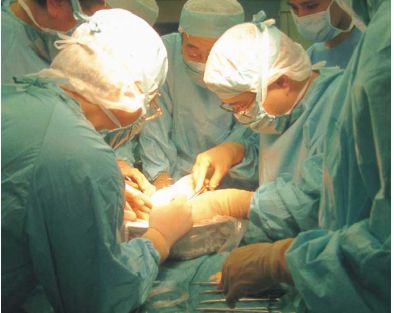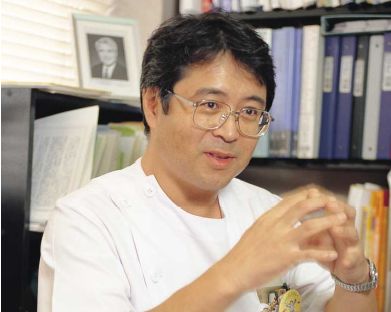QYou went to the US to study in 1987. What made you decide to go?
A: In 1983, I graduated from Kyushu University School of Medicine, and I was not sure which field I wanted to specialize in. I thought that I would have the physical strength to work in the surgical department, since I used to be a rugby player. For five years, I studied the basics for becoming a surgeon. In the fifth year, I studied at an affiliated hospital in Osaka, and the director asked me if I would like to study in the University of Illinois in the US. At the time, I was interested in studying in America, so I immediately replied "Yes, I'll go." I didn't know what I would do there, but I went regardless, with my wife and little son.
QHow was the US?
A: I didn't have enough time to prepare for my new life there. I didn't understand English, I didn't know how to live there, and I didn't know what I should do for my research. I decided that I wanted to at least pass a state examination, and to study English. At the same time, I began to conduct research into the relationship between brain nerves and the digestive tract, using laboratory rats. We know that stomach ulcers appear when we are under strong stress. I was trying to find out which particular nerves affect the production of ulcers. I thought we could treat ulcers without having to open the stomach. I repeated the basic experiments over and over again.
QHow long did you continue these experiments?
A: For three years. By that time, I had come to understand English pretty much, and had passed the state examination. It was at this point that a major turning
point in my life occurred. Dr. Todo from Kyudai had been in the University of Pittsburgh since 1984, conducting research into organ transplantation, and specializing in the liver. He gave me the opportunity to observe operations. Even in the US, there were very few transplantations being carried out at that time. I was able to see transplants of the kidney, the liver and the heart. The operations were amazing. It was as if Dr. Todo and his colleagues had magic hands. The patients, who had been struggling for breath, regained their health after the operations. It was at that moment that I knew that I wanted to become a surgeon, and gain the skills to perform operations and help patients. That moment has given me strength all through my career as a surgeon.
QYou moved to the University of Pittsburgh after that.
A: Dr. Todo suggested that it was necessary for someone to undertake the preclinical work for small intestine transplants. I decided to do this research in Pittsburgh. In those days, we knew nothing about the small intestine, because we couldn't see inside it with a camera, unlike the stomach or the large intestine.I did research into small intestine transplants using laboratory dogs. In the clinical department, I studied liver, kidney, and pancreas transplants, and performed my first operation. During my seven-year stay in Pittsburgh, I did 100 liver transplants, 123 pancreas transplants, and 250 kidney transplants. At that time in the University of Pittsburgh, many researchers were coming from all over the world and working very hard together. It was like the Olympic games. In addition to gaining medical knowledge and practical skills, I was able to learn to think freely, without being constrained in a Japanese way. Sometimes I fell asleep while eating, exhausted after performing several operations in a row, but during those busy days, I began to think that I wanted to work to establish organ transplantation in Japan.
QWhen you came back to Japan, what did you think about the country?
A: I found that Japanese society was completely different to American society, and I had reverse culture shock for several months. I thought that, for good or bad, Japan is undoubtedly a homogeneous country. It is one of Japan's unique characteristics.

QYou worked hard to promote transplantation in Kyudai.
A: I wanted to start pancreas and kidney transplantation at Kyudai. However, at the time there were many bureaucratic complications with regards to organ transplantation in Japan, and even though we had transplant techniques, they couldn't be performed. For two years after I came back, I talked with the Ministry of Welfare and other related organizations to establish rules for transplantation. At Kyudai, I tried to educate assistants skilled in transplanting because we have to work in a team. I also had to prepare documents to submit to the university ethical committee, and do clinics at the same time. I was all rather hectic.
QCould you tell us how transplantation came to be established?
A: In 1997, when I came back, the network for transplantation was established for the first time. In October of the following year, the Organ Transplant Law finally went into effect, and all the parties concerned in Kyudai and Fukuoka were ready for transplantation. However, for two years, there were no brain-dead donors. In 2000, the first donor appeared, which was national news, as you know. There have been 20 transplant operations using organs from brain-dead donors so far. It seems that Japanese people have come to accept the concept of brain death.
QCould you tell us your dream?
A: At the moment, we can only transplant to one recipient from one donor in the case of simultaneous pancreas and kidney transplantations. However, the pancreas can be divided into two parts, the pancreas head and tail. The kidney can also be separated into two. I want to divide a single organ and transplant the separate parts to help two recipients. I also want to do living-donor pancreas and kidney transplants, from a mother to her daughter, for example. I am seeking ways to perform these operations in Kyudai. For now there are several problems to be overcome, but if I keep persisting, my dream may come true in this or the next generation. That is my goal.
QPlease give a message to the students.
A: I don't want the students to become what I would call "I" type people, who are extremely specialized and excel in only one field, but rather that they would
become "reverse T" type people who are generalists but can still excel in one or two fields. I am trying to train the younger generation to become "reverse T" type people. I want the students to have a chance to develop the motivation to get into medicine. Students must have the heart, the real desire, to become a doctor with the responsibility of the patients. This desire will give them the inspiration and the
power to focus their minds in order to achieve their dreams. For the students who want to become surgeons, I would advise them to cultivate the particular skills required by the profession. These skills, like being able to rotate your wrist through 360 degrees, for example, may not be required in other walks of life, but as my former teacher used to say when he was training me "To become a surgeon, you have to be able to spin a plate."

